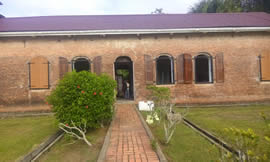"Renewable energy: Any energy resource that is naturally regenerated over a short time scale and derived directly from the sun (such as thermal, photochemical, and photoelectric), indirectly from the sun (such as wind, hydropower, and photosynthetic energy stored in biomass), or from other natural movements and mechanisms of the environment (such as geothermal and tidal energy). Renewable energy does not include energy resources derived from fossil fuels, waste products from fossil sources, or waste products from inorganic sources." - Texas Renewable Energy Industries Alliance
Wind energy technologies capture the natural wind in the atmosphere and convert it to mechanical energy for the production of electricity and other uses. Centuries ago, people were using windmills to pump water, grind grains and do other work. Today, the wind turbine, which is a much advanced version of the windmill, is used for the generation of electricity (see wind turbine picture, right).
Similar to the windmill, when wind blows pass a turbine, the blades capture the energy and rotate. The rotation in turn spins an internal shaft, which is connected to a generator through a gearbox to increase the speed of the rotation. The generator ultimately produces electricity. A wind turbine is equipped with wind assessment equipment and will automatically rotate to face the direction of the wind, and angle or "pitch" its blades to optimise energy capture.
There are three common types of wind-power systems:
- The Utility-scale system with large wind turbines (usually megawatt in size) for supply of electricity to the power grid. Many of such turbines are usually erected close together to from a wind plant or wind farm.
- The distributed or small system, with turbine of less than 100 kW, to directly power a home or business as its primary use. Like with the solar photovoltaic system, this type of system may be grid-tie so that electricity can be used from the grid in periods of little or no wind. Or, the system can be used with batteries to store energy when there is sufficient wind, for use when there is no wind generation.
- Off-shore systems with turbine erected in large bodies of water, such as in a sea or ocean.
Before wind turbines are installed in any area, a wind resource assessment is done, usually over a period of several years, to detemine the amount of energy that can be derived, and the viability of wind power generation in the area.
References:
- "Wind 101: the basics of wind energy," American Wind Energy Association, accessed July 25, 2015, http://www.awea.org/Resources/Content.aspx?ItemNumber=900.
- "Wind Energy Basics," National Renewable Energy Laboratory, accessed July 25, 2015, http://www.nrel.gov/learning/re_wind.html

